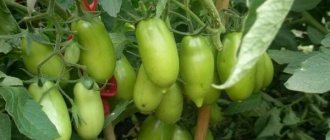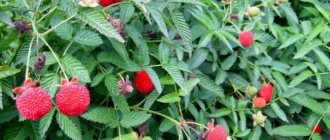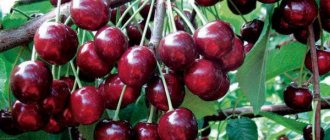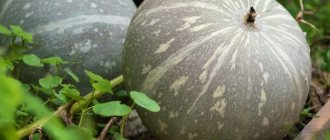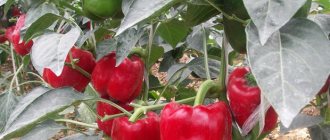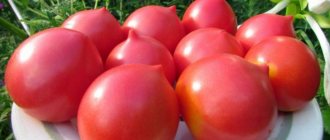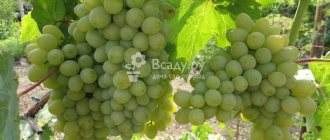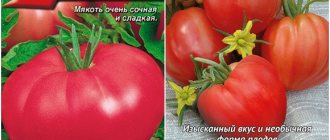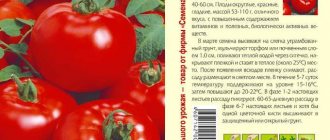Melon crops
- fruit and vegetable crops grown in certain conditions in “melon” (from the Persian
باغچه
- “garden”, “vegetable garden”), usually from the pumpkin family (
Cucurbitaceae
) such as: watermelon, melon, pumpkin.
Melon crops come from tropical and subtropical countries in Asia, Africa and America. Their fruits are eaten fresh and used as fodder crops, as well as in medicine. They contain potassium, calcium, sodium, magnesium, iron, phosphorus, sulfur. Melons and melons also contain vitamin C, carotene, thiamine, and riboflavin. Most melons have long stems creeping along the ground, large leaves and large yellow flowers, but there are also bush forms of plants.
Plants are almost not afraid of drought, as they have powerful roots. Growing quality food requires a lot of heat and sunlight. During the ripening period it should be hot and dry. There are suitable conditions for growing melons, for example, in Central Asia, the Lower Volga region, the North Caucasus, southern Ukraine and Moldova.
Pumpkin and melon crops growing tips
Melons and pumpkin crops are heat-loving plants. Germination of pumpkin seeds begins at a temperature not lower than 12°C, melon 13-15, watermelon 16 - 17°C. In years with a cold, long spring, shoots of melon plants appear on the 19-27th day after sowing, in favorable years on the 10th day. At temperatures below 12°C, plants develop poorly, pollen does not ripen, and fruits do not set well.
To form a normal harvest of even the earliest ripening varieties of watermelons, a frost-free period of 90-100 days is required, for mid-ripening varieties 120-130 days. For early ripening varieties of melons, a frost-free period of 80–90 days is sufficient. The best temperature for growth, development and maturation is 22-30°C.
Pumpkins and squashes can cope better with cooler, wetter summers. Frosts are detrimental to melon plants, although there have been cases where seedlings in the cotyledon and first true leaf phases survived light, short-term spring frosts without damage.
Watermelons and melons are especially demanding of heat and sunlight during the period of fruit formation and ripening. Cool, cloudy, rainy weather during this period delays ripening, reduces sugar content, taste and reduces yield. Pumpkins are lighter and tolerate moderate temperatures.
Melon plants, especially watermelons, are relatively resistant to air drought in the presence of moisture in the soil. They do not tolerate soil drought well due to intense evaporation from the large leaf surface. Pumpkins are the most moisture-loving. Watermelons can extract moisture from deep layers of the subsoil because... their root system is well developed. The main root grows almost vertically and goes to great depths. The lateral roots branch strongly and penetrate the soil in all directions in a layer of 5-40 cm.
Melon plants are especially demanding of moisture during the period of seed germination and emergence of seedlings. About a month after the emergence of seedlings, the root system begins to grow rapidly and the plants can take moisture from the lower layers of the soil. Lack of moisture in the soil and dry air during flowering and fruit growth have a negative effect. Excess moisture during this period reduces the sugar content in fruits, taste quality, and contributes to the spread of diseases.
Growing crops of the Pumpkin family
There are fundamental differences in planting and growing vegetables depending on the region. If in the south it is enough to plant seeds in the soil, perform minimal care manipulations and harvest the crop after a while, then in the central part of the country and the Far East it is necessary to carry out preliminary work both before planting and for growing melons.
Experienced melon growers advise sowing seeds for seedlings as early as March. Until summer she is kept in the apartment on the windowsill. And only at the end of May - beginning of June they are planted on a prepared bed. Transplantation is carried out extremely carefully, since the root system of melons is very fragile and delicate. A suitable method for transferring an earthen clod.
The nuances of melon growing in cold regions
Watermelons, melons, and zucchini are grown almost everywhere. To make this possible, experts advise:
- In the middle zone of the country, plant melons in the ground, but cover each sprout with a plastic bottle cut in half. The cover should be removed before watering. Place a 5-liter container on top of a 1.5-liter bottle, cutting off the bottom. When the plant outgrows the small container, it should be removed, leaving the larger one. This will create a mini-greenhouse for each sprout.
- In order for the vegetable to be filled with sunlight, the melon plant should be arranged in an open space without shaded areas. But in strong sunshine, it is worth covering the plants for a short time with large burdock leaves or using a light awning.
- For ease of care and space saving, it is better to plant the vine on supports. You need to stick poles along the bed with plantings, pull wire on them in 2-4 rows, and send the stem along this support.
- During prolonged rains, fruits lying on the ground will begin to rot, so it is necessary to place small planks, polystyrene foam under them, build sand mounds, or create some other safety cushion.
- In the central and eastern regions, groundwater very often lies close to the surface. Therefore, the overgrown roots, having reached them, begin to rot. If you initially water the plant not under the bush, but a little further away, the root system will not go deep, but will grow to the sides.
- On melons and melons, any canes that have arisen must be pruned. They leave one large stem-liana with flowers.
- Pinching is carried out after the 6th flower. If you leave more, the fruits will be small and tasteless.
All care for melons after planting seeds or seedlings in open ground consists of abundant watering, pinching, fertilization, protection from rotting and protection from diseases.
Selecting a site for sowing
Melon crops grow well on virgin, fallow lands, as well as on layers of perennial grasses. Using these predecessors, the yield is higher, harvesting starts 7-12 days earlier, and the plants are less affected by diseases. In the absence of a layer, melon crops can also be placed on old arable lands.
When choosing areas for melons, especially for watermelons and melons, it is necessary to give preference to areas with a gentle southern or southwestern slope, if possible, protected from cold winds. These slopes warm up better, are well illuminated by the sun, there is less likelihood of spring frosts and there are weaker fluctuations in night and day temperatures, plants suffer less from anthracnose.
Melon crops grow better on light-textured, well-warmed soils with a sufficient content of organic matter. Pumpkin also grows well on heavy loamy soils when organic fertilizers are applied.
Watermelons and melons develop well on pine sands located along the edges of ribbon pine forests or in clearings in the forest. On soils with light mechanical composition, ripening is accelerated and the sugar content of fruits increases.
Diseases of melons
The greatest threat to melon crops is fungal diseases. The risk of plant infection increases under negative weather conditions or large amounts of moisture. The most common diseases of melons and melons are the following:
- Anthracnose;
- Fusarium;
- Downy mildew;
- Powdery mildew;
If melons are severely infected by such fungi, approximately half of the entire crop may die. In order to avoid this situation, it is necessary to feed the plants. Fertilizing will significantly increase the plant's resistance to various diseases and will allow it to more resistantly tolerate unsuitable environmental conditions.
Another effective method is to alternate sowings at various intervals. When a certain crop is constantly planted in one place, a large number of pathogens accumulate in the soil and the chance of an outbreak of a dangerous disease increases many times over. But other crops may be immune to this type of disease and the pathogens will simply die.
Preparing seeds for sowing
Pre-sowing preparation techniques are varied. For sowing, it is better to use seeds that have been stored for 2–3 years. When sown with seeds from the previous year, the plants produce female flowers later and in smaller quantities, and the yield is lower. However, if prepared accordingly, they are not inferior to seeds stored for 2-3 years.
In this case, pre-sowing heating of seeds at a temperature of 40-50°C for 5-7 hours or at a temperature of 60-70°C for 2 hours is effective. In this case, the temperature must be increased gradually, and the seeds must be scattered in a layer of no more than 10 cm. Seeds from the previous year, stored in a cold room in winter, when heated for 5 hours at a temperature of 50°C, increase the yield by 20-30%, and the productivity of the first harvests by 1.5-2 times.
Air-thermal solar heating of seeds before sowing significantly reduces the period before emergence, increases field germination and seed germination energy, accelerates seed ripening and increases yield. Positive results are obtained by soaking seeds in a 0.05% solution of manganese sulfate for 16 hours.
Experienced melon growers know that a good harvest can be obtained from large, full-bodied seeds. The most accessible way to select such seeds is in a 9% saline solution, in which the seeds are kept for 2-3 minutes, then washed with clean water.
In some cases, good results are obtained by treating seeds with variable temperatures - seed hardening, which is carried out in the following way: seeds in gauze bags are soaked in water for 12 hours, after which they are placed in glass jars and left for 12 hours (day) in a room with a temperature 15-20°C.
For the next 12 hours (night), the seeds are buried in the snow. Thus, the seeds are processed for 10 days. In cold, protracted spring conditions, sowing seeds in unheated soil does not give positive results. Under such weather conditions, it is better to postpone sowing to a later date, and store the seeds this time on a glacier, in a refrigerator at a temperature of 1-3°C. Treatment of seeds with variable temperatures, as experiments have shown, is best carried out in this mode: maintain for 8 hours at a temperature of 15-20°C and 16 hours at a temperature of 1-3°C.
Storage of melons
The average shelf life of melons is 1.5-2 months. Under such conditions, melons can be stored in ordinary basements or granaries. However, if it is necessary to increase this period by a month, they resort to special vegetable storage facilities. There, melons are stored on special racks with ideally selected humidity and temperature. It is not enough to simply place fruit on a bare rack and expect an acceptable result. Melons should be stored on a special litter, which significantly increases the shelf life. Sawdust, straw, cotton wool and even regular sand are good for bedding. This insulating material reduces pressure on the lower part of the fruit and helps maintain the integrity of the vegetable structure longer.
Under such conditions, melons can be stored for up to three months, but the percentage of spoiled vegetables reaches 60-70%. Therefore, the optimal storage period is two months. During this time, the fruit retains most of the beneficial microelements and remains relatively fresh.
Dates and methods of sowing
At low temperatures and high soil and air humidity, melon seeds do not germinate for a long time (up to 3 weeks). Therefore, with very early sowings in unheated soil, seedlings do not appear for a long time, and in prolonged cold weather they may not appear at all or will be sparse. If planted late, the fruits may not ripen. The best results were obtained when sowing watermelons in mid-May, melons on May 15-20, and pumpkins on May 10-20. Pumpkins tolerate early sowing times better than other melon crops.
Depending on weather conditions, dates may change. With an early friendly spring on the southern slopes, sowing can be done earlier. The depth of seed placement depends on the mechanical composition of the soil. On light soils, seeds are sown deeper than on heavy soils; taking into account the conditions, watermelon seeds are sown to a depth of 4-8 cm, melons 3-6, pumpkins 7-10, zucchini, squash 6-8 cm.
To obtain an earlier harvest, 20-25 day old seedlings should be grown in the same way as cucumbers. Seedlings are planted after the end of frost (June 10-15). The distance between the holes is 50-70 cm; two to three plants are planted in each hole. The technique for planting seedlings is the same as for cucumbers. Sow seeds in holes of 5-8 pieces, and after thinning, leave two to three plants. Watering is carried out regularly and only with warm water. After each watering, it is necessary to loosen the soil well. Long-climbing pumpkin varieties are best placed along the edge of the garden, while short-climbing pumpkin varieties can be grown inside the garden at a distance of 1 m.
Disease Control Measures
The first stage in the fight against diseases of melons is the disinfection of seeds before planting. Etching is carried out using a solution of copper sulfate or zinc sulfate.
Other measures are presented in the table:
| Disease | Signs | Causes | Treatment |
| Fusarium | The fungus penetrates the root system and cannot be visually detected in the first stages. | Over-humidification and night temperature drop to +16° | The plant should be removed and the soil should be disinfected with copper sulfate |
| Anthracnose | Yellow and brown spots appear on the leaves, then they increase in size, spread, forming ulcers, and the fruits rot | The causative agent is a fungus that is initially found in the ground | Spot spraying with Bordeaux mixture. The course consists of 3 procedures with a week interval. The soil is disinfected with potassium permanganate or copper sulfate |
| Root rot | Weeping brown and black spots begin to spread from the bottom of the leaf, spread to the shoots, and eventually absorb the entire plant | Widely varying temperatures and humidity levels, excessive application of root fertilizers | They treat only at the first stage: the water for irrigation is replaced with a solution of potassium permanganate, the roots are taken out of the ground, first treated with copper sulfate, then sprinkled with ash, and after treating the soil, they are buried. In neglected varieties, melons are destroyed |
| Bacterial spot | The fruits develop spots that are watery to the touch and yellow-green in color. Over time, they grow, turn into growths, the leaf turns black, the fruit dies | The disease is carried by insects | There are no drugs for treatment. In the primary stage, all leaves are cut off. If this does not help, the plant must be destroyed. |
| Powdery mildew | The leaves look like they are dusted with flour. Over time, the fungus turns brown and turns into a growth | The disease is fungal, found in the ground or on seeds | The bushes are treated with Karatan, Bayleton, Topaz, the infected parts are cut off and burned |
| Mosaic disease | Vast light areas appear on the leaves, later the plant becomes deformed and dies. | The viral disease is transmitted by insects contaminated with tools and seeds | For primary signs, spray with Karbafos 2 times with a difference of 7 days |
| Leaf rust | The plant is covered with shapeless rust-colored tubercles. Powdered spores spill out from cracked tubercles. | Infection with rust fungi as a result of excess nitrogen and high humidity | The affected parts of the plant are cut off and destroyed, then everything is treated with fungicides |
| Olive spot | Weeping gray-green spots appear on the fruits, the leaves become fragile, and the crop dies within 10 days | Unresolved infection in the ground | At the first stage, Bordeaux mixture is used. If time is lost, they are treated with Abigo-Peak, Oksikhom. Course 3 times, interval 7 days |
Growing any variety of melons and melons in Russia is not very difficult. It is enough to follow basic rules and carry out disease prevention in time.
Harvesting and storage
Zucchini and squash are cut regularly, preventing the fruit from overgrowing. The pumpkin is harvested when completely ripe. Zucchini fruits are harvested when they are no more than 10-15 cm, they are cut with a knife. Melons and watermelons are harvested selectively. The onset of removable ripeness of watermelons is determined by the drying of the stalk, melons by a change in color, free separation of the stalk from the fruit, and a strong aroma.
By properly storing melons and melons, you can significantly extend the period of fresh consumption. It has been established that it is better to take fruits grown on light sandy loam soils for storage. If the area is irrigated, then watering must be stopped for 2-3 weeks before harvesting. Fruits of mid-late and late varieties, collected in dry, sunny weather, are stored better.
The structure of melons
All melons are annual plants and consist of three components - bark, pulp and seeds. The plant bark is uniform in structure and rigid enough to prevent possible damage to the fruiting body. The pulp is the edible part of the fruit with a high moisture content. The seeds may be embedded in the pulp or located in a certain cavity of the fruit closer to its middle. There are three systems of feeding vessels in the fruits of melons:
- passing through the center of the fruit;
- along its periphery and
- in the middle of the cow pulp.
These systems are interconnected and have a branched system that covers the entire fruiting body. Typically, three to five large vessels pass through the center of the fetus, which bear the main load. Then they branch and completely provide the fetus with the necessary nutrients.
The structure of melons using the example of watermelon
Growing melon (planting and care). Melon varieties with descriptions
- MarinaMelon crops 06/08/2018
Growing melon (planting and care).
Varieties of melon with description Today we will get to know melon . Let's find out where it came to us from and what types of melon there are. Let's talk about growing melon , namely how to plant and how to care for it.
Yellow, ripe, juicy, beloved - these are the epithets that are suitable for such a fruit as a melon. It is she who opens the summer season of sweet vegetables. Its sweet honey taste has captured the hearts of many people. (Further…)
Pre-landing activities
Planting seeds at home or in a greenhouse is preceded by a number of mandatory measures:
- Soil preparation.
- Processing of planting material.
Similar actions will be required when sowing seeds directly to a permanent place under a temporary film cover.
Soil preparation
Preparatory work consists of the following stages:
- The first and most important thing is crop rotation. It’s good if the predecessors of melon were legumes or grain crops, tomatoes, cabbage, potatoes.
- Watermelons love light, fertile soils. At home, prepare a soil mixture of sand and humus with a small amount of mineral additives. At a summer cottage, organic matter (manure) and wood ash are added to the soil for digging.
Autumn and spring plowing of the soil allows you to rid young plants of many unwanted parasites and diseases.
Seed processing
Watermelon seeds remain viable for at least 6-7 years. To increase the germination of seeds, the following techniques are used:
- Soaking . Seeds pre-calibrated by size are pickled for 12-24 hours in a weak solution of potassium permanganate or a specialized drug that stimulates growth activity. The exception is seeds treated with nutritional and disinfecting compounds by the seed manufacturer.
- Warming up . This technique not only promotes rapid seed hatching, but also stimulates the formation of female flowers. Seeds in gauze or other breathable fabric are released into hot (no more than 60 C) water for 2-3 minutes. The swelling seeds are left in a warm and humid environment for up to 2 days.
- Germination . With proper selection and processing of planting material, watermelon seeds will sprout quickly. You can speed up the process by performing scarification—damaging (filing) the tip of the upper hard crust of the seed. Well-known for their slow germination, swelling seeds can germinate within 2-7 days.
- Hardening . At the first signs of pipping, hardening is carried out. The container with seeds is placed in the refrigerator on the bottom shelf and kept for up to 10-12 hours. The procedure with alternating heat and cold is carried out 2-3 times.
When the sprouts reach a length of about 1 cm, they are planted in the spilled hole. In open ground and in a greenhouse, 3-6 seeds per hole, with the seedling method - one per peat pot. The depth of embedding should not exceed 4-5 cm.
Growing watermelon. Watermelon varieties
- MarinaMelon crops 01/08/2018
Growing watermelon. Watermelon varieties
Well, what summer is complete without watermelon? This traditional summer berry makes us happy every year and decorates summer tables starting from July.
the watermelon came to us , what varieties it comes in, how to plant it , grow it , and how to care for it. Although watermelon is a southern plant, thanks to modern selection it is possible to grow watermelon , you just need to choose the right variety and provide the necessary care . (Further…)
Selection of watermelon and melon seeds
Selecting seed material is a responsible job. If you make the wrong choice, all your hard work will be in vain. Seeds need to be purchased in specialized stores. It is best to give preference to varieties with small fruits. When purchasing seed material, the following indicators should be taken into account:
- The place where the seeds were produced. It is advisable to select a region close to the further planting site.
- The period during which the fruits ripen. It is better to give preference to a short period of time, so that the fruits have time to ripen. Otherwise, you may be left without a harvest.
- Fruit size. You don’t have to believe that melons will grow huge. This can only be achieved in the southern regions. For the greenhouse, it is necessary to select varieties with a small fruit size.
- Best before date. Fresh seeds have a higher germination rate.
Lagenaria. Growing and care. Lagenaria varieties
- DenisMelon crops 08/17/2017 comments 2
Lagenaria is a vegetable and ornamental plant at the same time
Lagenaria is still a little-known vegetable to us. If you plant this wonder in your garden or vegetable garden, you will certainly surprise your guests with this overseas wonder. The vegetable is truly overseas, it came to us from the countries of Africa and Asia. It is similar in color to zucchini, the shape comes in several forms depending on the variety, but despite its appearance, this vegetable is essentially a pumpkin.
Since ancient times, the tribes of Africa have used Lagenaria not only as a vegetable that was used as food, but also to make dishes, musical instruments and food storage containers from it. Lagenaria is used today in the same way as then. We will consider all this in detail in our article. (Further…)
Patisson (Cucurbita pepo var. patisson)
Melon culture, which in Latin has the name Patisson,
very similar to zucchini in terms of growth. Some even plant these plants together for joint pollination.
In some sources you can read that squash tastes like a porcini mushroom and is sweeter than zucchini. Everyone's taste buds are different, but these plants taste almost the same.
The same applies to planting this plant. If you do everything the same way as for zucchini, you won’t go wrong. There’s just one caveat: squash likes a little more heat , so plant them a week later than zucchini.
Squash fruits come in different colors: white, yellow and green. Again, everyone chooses to their own taste. There is an opinion among gardeners that the yellow fruit has the best taste.
One of the varieties of yellow squash is called “Sun”, and the average weight of the fruit reaches 300 g. The green squash variety “Bingo-Bongo” bears fruits weighing up to 600 g.
Watermelon. Growing watermelons in open ground
- DenisMelon crops 06/20/2017
Growing watermelons may seem like a labor-intensive task at first glance, but in reality there is nothing difficult or complicated
Watermelon is the most popular melon crop of the pumpkin family . Its juicy, sweet fruits leave no one indifferent. Watermelon comes from South Africa.
Growing watermelons in open ground is not such a difficult task. In Russia, watermelons are successfully grown in many regions .
It is believed that these plants are quite demanding in their care and you need to try hard to get their tasty fruits. But the devil is not as terrible as he is painted. In fact, growing watermelons (with the exception of some nuances) is not much different from growing well-known zucchini and pumpkins. (Further…)
General information and description of melons
Melons prefer a warm climate and plenty of sunshine. The soil can be quite sandy, but black soil is also good for growing these plants. Plants tolerate drought or little watering well, but rapid growth can only be achieved through regular and abundant watering. Low temperatures are destructive for melon plants, so when planting you need to take into account that spring frosts can completely destroy all crops.
Part of the melon crops is used to feed cattle. Thanks to a large amount of useful microelements, these plants prevent many diseases among animals and significantly increase their immunity. Some plants are used for medicinal purposes to produce medicines. But most species are still used directly by humans for food. Melons can be eaten fresh or can be preserved, which allows plants to be stored for a long time.
Chayote (Mexican cucumber). Growing and care.
- DenisMelon crops 01/12/2016
In the central zone of Russia, chayote is grown as an annual crop, in the south - as a perennial crop.
Chayote grows in tropical areas of Central America. Chayote is a perennial plant of the Cucurbitaceae family. Its shoots bear fruit abundantly and reach a length of 15-20 m. The fruit is a large ovoid, pear-shaped or conical berry weighing from 200 g to 1 kg, color from dark green to cream. The pulp of the berry is transparent, glassy, with one flat seed 6 cm long.
In the central zone of Russia, chayote is grown as an annual crop, in the south - as a perennial crop. The duration of fruiting depends on the fertility of the soil. Chayote produces a rich harvest (up to 20 kg/m2). The fruits are stored well until May. There are mainly three varieties of chayote cultivated: white, green and French. (Further…)
Biological features of zucchini
An annual plant from Mexico and the regions adjacent to it in the north, a representative of the pumpkin family (Cucurbitaceae), cross-pollinating, chromosome number 2n=40. The stem is bushy, shortened, of two types - branching and non-branching. Plants form a powerful, deep root system. Leaves with five-lobed or slightly divided blades covered with subulate-shaped omission. The flowers are dioecious, monoecious, large, yellow-orange, pollinated by insects. The fruits are cylindrical or slightly curved, white, dark green, green, gray with various shades, 30-50 cm long, 8-15 cm in diameter. The pulp is white. The seeds are yellow, cream, medium or small, with a smooth surface and a clear rim along edges. The plant is heat-loving, but less so than many other crops from the same family. Thanks to this, its range reaches 60° N. w. The optimal temperature for it is 24-28 ° C. Seeds begin to germinate at 15.5 ° C, but much faster at 25-30 ° C. The growth of vegetative organs begins at 12-13 ° C, fruits - at 15-16 ° C, but they grow most intensively at 22-26° C or more.
Zucchini is a light-loving plant, but it tolerates prolonged cloudiness well under optimal temperature conditions. But shading impairs growth and development. The reaction to day length is neutral. This plant is less demanding on soil moisture than pumpkin, although moisture supply is an important condition for achieving high productivity. High soil fertility and looseness also have a beneficial effect on productivity.
The duration of the growing season is 90-100 days. From germination to technical ripeness of the first fruits, 45-60 days pass. Zucchini has a high potential productivity, reaching 90-100 tons per hectare.
Melon. Growing melon in greenhouses, greenhouses and under film
- DenisMelon crops 11/28/2016 1 comment
Melon is grown on light soils, but with a high enrichment of organic matter.
Melon is a heat-loving plant of the pumpkin family. Its sweet fruits, like watermelons, are a dessert dish. Melon has been around for many tens of thousands of years. This is known thanks to numerous finds by archaeologists. Experts believe that the melon is a descendant of perennial forest vines of the Tertiary or even Cretaceous period.
Poets of the Ancient East sang this plant in their works, Muslims considered it sacred. In Europe, where melon came under the name “melo-pomo” from Asia Minor and Central Asia, it was perceived simply as a dish not devoid of a pleasant taste. The popularity of melon has always been very great, but it also had a downside. There are known cases of death from melon abuse (simply overeating) of many people, including four emperors and even Pope Paul II. (Further…)
Caring for watermelon and melon seedlings in a greenhouse
If the basic conditions are met, the seedlings will develop quite quickly.
- It is important to provide the seedlings with plenty of space. Neighboring plants should not be allowed to touch each other.
- Carrying out two feedings. This will fill the seedlings with strength and energy before planting in the ground. As a top dressing, you can use a composition of mineral fertilizers diluted in water. The first subcortex is necessary a few weeks after sowing the seeds.
- Lighting should be present up to 14 hours a day. If necessary, you can use an additional light source. If there is a lack of light, the seedlings will weaken and stretch out.
How to grow watermelons in open ground, greenhouses and greenhouses
- DenisMelon crops 11/28/2016 1 comment
In sunny areas well protected from the wind, watermelons can be grown without insulated soil.
Watermelon is the main melon crop in the European part of our country, with crops covering more than 500 thousand hectares. The word “melon” is of Tatar origin; translated into Russian it means “garden”.
This annual plant with a vine-like stem structure and a well-developed root system was called watermelon by the Persians. This word has taken root everywhere and is used by all peoples of the world. Watermelon culture originated in Rus' in the Lower Volga region already in the 7th century, but only a thousand years later they began to show interest in watermelon in the central regions of the country. The watermelon fruit (false berry) is the largest in the plant world. Its weight often reaches 20-25 kg, and there are giant watermelons (over 50 kg). (Further…)
Activities for caring for watermelon and melon in a greenhouse
After planting the seedlings in the ground, you need to give the plants a rest for several days. Further care involves the following work:
- Ventilation. The temperature should not be allowed to exceed 30 degrees. During hot periods, it is important to ventilate. To do this, you will need to open the windows slightly or remove the film.
- Watering. For irrigation, only warm water should be used. When carrying out work, you must avoid getting water on the sheet plates. This can cause them to rot.
It is important to remember that overwatering can harm crops. As a result, fungal diseases will appear, and the berries may crack.
3. Feeding. These activities must be carried out before the fruit ripens. Feeding should be done once a week. In order for plants to receive useful elements, it is necessary to water with the following composition: water, ammonium nitrate, nitrogen fertilizers.
4. Carrying out pinching and gartering. When the fifth leaf forms, the growing point should be cut off. After the ovaries acquire the size of a plum, only one should be left on all the lashes, and the remaining ones should be removed.
Gartering can be done within ten days from the time the seedlings are planted in the ground. To garter fruits, use the following method: the fruits must be placed in the center of the net, the edges tied, and hung from the trellis using twine. This method of gartering will help protect the fruits from dampness and disease.
5. Pollination. The procedure must be carried out in the morning. Pollination will require some effort. This is due to the fact that bees do not visit the greenhouse, and it is necessary to carry out artificial pollination measures.
To carry out the procedure, you need to select large male flowers and touch the stigmas of female specimens. It is recommended to carry out this procedure several times.
It is important to remember that pollination must be carried out in a short time. Male representatives can live only a few hours. If the procedure is carried out at the wrong time, you can lose the entire harvest.
Forage melons
Melon crops - watermelon, melon and pumpkin - are cultivated to produce juicy fruits with high nutritional value. Fresh fruits of forage varieties of pumpkin and watermelon are usually used to feed livestock. They are a valuable milk feed. 100 kg of feed pumpkin contains 10 feed. units and 170 g of crude protein; 100 kg of feed watermelon - 9 feed. units and 70 g of crude protein. Edible oil is obtained from the seeds of melons, especially pumpkin.
Melon growing in Russia has been developed since ancient times. Industrial melon growing arose in the middle of the 19th century, when melon crops occupied significant areas in the Lower Volga region and the Kuban. In subsequent decades, the boundaries of melon growing moved significantly to the north and east. The sown area under melons is more than 100 thousand hectares. The main areas of cultivation of watermelon are the Middle and Lower Volga region, the North Caucasus, pumpkins are the central regions of the Non-Chernozem Zone, the Black Earth Zone, Trans-Urals, Siberia.
Abroad, melons are cultivated in many countries in Asia (especially China, India, Japan), Africa, Central and South America. Among European countries, Bulgaria, Hungary, Romania, b. Yugoslavia and Italy.
The yield of the best varieties of watermelons on non-irrigated lands is 25...30 t/ha, and on irrigated lands - 40...50 t/ha or more. The yield of melon ranges from 16... 18 to 50 t/ha, pumpkin - from 35 to 70 t/ha and more. The highest yields of melons and melons are obtained in the Lower Volga region and the North Caucasus.
Watermelon (Citrullus lanatus)
If you want to plant a watermelon on your site, then first you must carefully select the variety, and only then plant the seeds. Some varieties of watermelon will not be able to fully grow in conditions of black soil and high air humidity. Therefore, the best varieties of watermelon are considered to be: “Astrakhansky”, “Kamyshinsky”, “Monastyrsky”.
It is best to plant two-year-old seeds. To harden them from the cold, they can be planted in peat cups and kept in a cold place for no more than a day. It is recommended to plant already germinated seeds in the soil. To do this, they need to be kept in a wet cloth for about two days, and only then planted in the open sky.
It will be good if the area where you plant the watermelon previously grew perennial herbs or one of these plants:
- winter wheat;
- corn;
- leguminous crops;
- potato;
- cabbage;
- carrot.
Many people do not know what to plant next to melons. The best neighbors will be:
- potato;
- corn;
- peas;
- beet;
- sunflower.
The watermelon breaks through the soil about the tenth day after planting. Next, it needs good care. During the entire growing season, the plant needs to be weeded 4-5 times and watered 9-12 times with not very cold water. It is worth noting that if you water frequently, this can lead to fungal diseases. With excessive watering, pumpkin (watermelon fruit) loses its taste and becomes watery.
Fertilizers for melons and melons should be selected very carefully. Excessive addition of nitrate fertilizers can be harmful to human health. Experts recommend adding mullein infusion when planting seeds, and this will be enough.
Watermelon fruits can be in place by mid-October, in some regions - by mid-to-late September. If the fruit is ripe, then when you hit it with your palm, you will hear a dull sound . Collected seeds can be stored in a dark place for about 4-5 years and remain suitable for planting.
Botanical description
Melons belong to the Pumpkin family - Cucurbitaceae, which includes three most important genera in culture: watermelon (Citrullus), melon (Meld) and pumpkin (Cucurbita). Plants of these genera are annual; they are very similar in the structure of their vegetative and generative organs.
Watermelon is represented by two types: table watermelon - Citrullus lanatus (Thunb.) Mansf. var. citroides (L.; Bailey) Mansf. and feed watermelon (candied) - Citrullus colocynthoides Pang.
Table watermelon has a taproot, highly branched root, which reaches a depth of 3...5 m and spreads laterally within a radius of up to 7 m. The stem is creeping, long-climbing (2...5 m), with 5...10 branches covered with hard hairs. The leaves are strongly dissected into pinnately cut lobes and rigidly pubescent. Flowers are quintuple, yellow, dioecious; female flowers are larger than male ones, and bisexual flowers are also found. Cross pollination with the help of insects. The fruit is a multi-seeded false berry (pumpkin) on a long stalk, spherical, oval or oblong, colored white-greenish or dark green, 1, often with a marble pattern. The bark of the fruit is leathery, fragile, from 0.5 to 2 cm thick. The pulp is of varying consistency, carmine-red, pink, less often white or yellow, tastes sweet or slightly sweet. The pulp contains 5.7...13.0% sugar. Fruit weight is 2…20 kg. Watermelon seeds are flat, ovoid, 0.5...2.0 cm long, with a scar along the edge and a hard skin of white, yellow, gray, red and black color, often with a spotted pattern. Weight of 1000 seeds 60... 150 g.
Characteristics of melon varieties
The list of plants growing on melons includes watermelons, melons, zucchini, squash, and pumpkins. Most of them have long vines with large leaves and yellow single flowers creeping along the ridges. They tolerate dry weather well, since their powerful and strong root system can “extract” moisture from the deepest layers of the soil.
Melon growing is a simple science. Crops require a lot of sun and heat; the weather at the time of growth should be hot and dry. But when purchasing seed material, it is important to pay attention to the growing season. If the planting area assumes a rapid summer, only early species with a ripening cycle of no more than 90 days are planted.
Watermelon
There is a huge variety of varieties of melons such as watermelon. In addition to the fact that there is a division into table and fodder types, this berry varies in weight, shape, color of pulp and peel, taste, location and method of cultivation.
General characteristics of the plant:
- The stem, reminiscent of a vine, is long, flexible, curly, rounded, and can reach 5 m in length.
- The leaves are wide, attached to the trunk with short petioles. The leaf blades are large - about 25 cm long, 20 cm wide.
- The flowers are yellow - 2.5 cm in diameter, unisexual.
- The fruits are oval, round, square, pyramidal.
- The pulp with numerous seeds is yellow, red, pink.
To date, more than 1000 varieties of the largest berry in the world have been grown, and they are all different from each other. Not only the form, but also the content can be unusual. The recently released seedless fruits are surprising. They are grown using a special pollination technology.
The following groups of watermelons are conventionally distinguished:
| No. | View | Description | Photo |
| 1 | Colocynthus | The plant has round leaves, large flowers, and small fruits. The rind of a ripe watermelon is yellow and dense. The pulp is white with a slight yellowish tint. Has many useful substances. In some countries it is used as a medicinal product. Suitable for preparing powders, extracts, oil is squeezed out of seeds | |
| 2 | Ordinary | The largest species group of watermelons, annual. The shape is ellipsoidal or round, the skin is green to dark green with or without stripes. The pulp is red, white, yellow. Has a high sugar content, size depends on where it is grown. The seeds are dark, flat, the stems are like a creeping vine, the leaves are fleecy, hard, about 22 cm. Excellent taste | |
| 3 | Square | Similar to normal. The unusual shape allows for easy transportation and storage. The cubic configuration is obtained due to the peculiarities of cultivation: when the future watermelon reaches the size of a large onion, it is covered with a cube made of plywood or wood |
In areas with cold climates, to increase the ripening period, seeds are not planted directly into the soil. The first stage of growing watermelons is planting seedlings in early spring. Only in this case will a fully ripened product be obtained by mid-September.
Melon
The fragrant fruit belongs to the Pumpkin family. The pulp contains a high level of easily digestible sugars, fiber, vitamins, minerals, etc. Recommended for use in case of deteriorating health:
- of cardio-vascular system;
- for inflammation of the genitourinary system;
- kidneys and gallbladder;
- nervous system;
- in case of immune system failures;
- as an antiparasitic (anthelmintic) agent.
Unlike watermelon, which is considered a berry, melon is recognized as a vegetable.
Melon is an excellent auxiliary remedy for many diseases; it is recommended by doctors as a nutritional component. But still, this fragrant fruit has contraindications:
- Not recommended for diabetics, as the product contains up to 13-15% sugars (depending on the variety). If the patient has a stage 2 disease, you can use the bitter variety, it reduces the glucose level.
- For liver diseases.
- Children under one year old.
- With great caution for those who have gastritis and ulcers.
- Diarrhea and other gastrointestinal disorders.
- For diseases of the spleen, the fruits are consumed with honey.
Melon consists of 90% water, and additionally contains a huge amount of carbohydrates. Therefore, nutritionists recommend eating it as an independent dish, without mixing with other products.
Pumpkin
The shape of the fruit can be very diverse - round, oval, small (decorative) or large, have a hard crust on top and pulp inside. All these parameters depend on the variety and growing conditions. The flat seeds, about 3 cm, have nutritional and medicinal value.
Pumpkin is a very important agricultural plant; it is easy to grow and subsequently there are no difficulties with storage. In cooking, the vegetable is used to make purees, soups, sweet pastries, jam, juice, etc.
The vegetable is used for the following diseases:
- anemia and other types of anemia;
- male weakness;
- cardiovascular disorders;
- diseases of the nervous system;
- various gastrointestinal disorders;
- obesity;
- chronic tuberculosis, etc.
However, there are a number of contraindications and restrictions:
- Not to be used for diabetes of all degrees.
- Raw fruits and juice are prohibited for ulcers.
- Do not drink juice in its pure form if there are gastrointestinal disorders.
Some people's bodies do not tolerate any type of pumpkin well, and an allergic reaction is possible.
Zucchini and squash
The list of melon crops additionally includes squash and zucchini. They are similar in taste, presence of nutrients and minerals, beneficial properties for the body and contraindications.
Benefits of vegetables:
- Squash skin contains antioxidants that rid the body of free radicals, prevent the development of cancer, and preserve youth.
- They contain potassium, which is necessary for the heart muscle and normalization of blood pressure.
- Both vegetables contain fiber, which reduces the risk of tumors in the rectum.
- Patisson is a natural source of folate. It is important in cell division and DNA synthesis.
- Controls the level of bile and glycogen.
- Thanks to its diuretic property, excess fluid and sodium salts that cause fluid retention are removed.
- Squash is useful as an adjuvant for prostate cancer.
Medicine claims that both zucchini and squash contain quite a large amount of vitamins (C and group B). But it must be remembered that the data presented in various sources corresponds to fresh vegetables.
Harmful properties of zucchini and squash:
- Canned melon derivatives are not recommended for consumption by those with diabetes.
- Not indicated for hypotensive patients.
- Should not be used if you have digestive disorders or gastrointestinal problems.
Features of biology
Table watermelon is a heat-loving, heat-tolerant and very drought-resistant plant. Its seeds begin to germinate in moist soil at a temperature of 16...17 °C. Shoots appear on the 8...10th day. The most favorable temperature for the growth of stems and leaves is 20...22 °C, and for the development of fruits 25...30 °C. Table watermelon is a light-loving short-day plant. The best soils for it are sandy and sandy loam.
Fodder watermelon, compared to table watermelon, is less demanding on growing conditions.
In its biological characteristics, melon is close to watermelon, but it is more heat-loving and less drought-resistant, and tolerates loamy soils.
Pumpkin is less heat-loving and drought-resistant than watermelon and melon. Its seeds begin to germinate at a temperature of 12... 13 °C. Seedlings suffer less from frost. Pumpkin grows best on loamy soils.
Zucchini (Cucurbita pepo var. fastigata)
Zucchini is another representative of melons. It needs less sunlight and tolerates colder air temperatures better. Melon plants such as zucchini can be planted as seedlings 10-20 days earlier than watermelon and melon.
Read also: DIY crafts from a gas cylinder
After the planted seeds break through and become two or three petaled, they can be planted in the open sky.
Before this, the soil needs to be loosened and fertilized with phosphorus and potassium mixtures. You can use mullein infusion. When planting in the ground, you need to add a little water and add wood ash. This will protect the plant from various diseases.
Zucchini cannot be planted in the place where pumpkin, squash or cucumbers used to grow. It is advisable to change the planting location of this melon plant every year and not plant it there for four years. During the growing season, the plant must be sprayed with various mixtures in order to prevent pests from destroying the zucchini. You also need to regularly water and weed the plant, then the fruits will be as large and tasty as possible. In general, growing a melon crop such as zucchini has become an integral part of any gardener in our region. Therefore, many people know that if the plant is properly cared for, then within 35-40 days it will bear its first fruits.
Seedlings in the garden
When sowing melons in a permanent place, the seedlings are thinned out, leaving 2-3 of the most viable plants in the hole. In the climatic conditions of the middle zone, it is worth limiting yourself to 1 shoot.
Watermelon seedlings are in dire need of light and warmth. It is unacceptable to water plants with cold water and leave them in a draft. Fertilizing with nutrient solutions once a decade has a beneficial effect, but fertilizer should not be allowed to get on the leaves. Watermelons need to be watered at the root.
You can plant seedlings in a permanent place with the onset of real warmth, at daytime temperatures above +18−20°C and night temperatures not lower than +15°C.
The seedlings are growing quickly. Young watermelons have a powerful, but very fragile taproot system, and they soon become cramped in the pot.
The soil in the garden bed for melons will quickly warm up if you cover it with black film in advance.
Young plants are planted in a spilled, fertilized hole without deepening the neck. The cotyledon leaves should be above the soil surface. To avoid rotting of the stem, it is sprinkled not with soil, but with sand. Each planting hole requires at least 2 liters of water.
It is advisable to build a temporary mini-greenhouse over the plantings from arcs or scrap materials. At first, keep the plants under cover constantly, then cover them only at night with covering material in case of sharp fluctuations in day and night temperatures.
Using watermelon in cooking
Like all natural products, watermelons and melons are very beneficial for the human body.
Thus, watermelon has a very positive effect on the kidneys, helping to remove stones and sand from them. This vegetable is also useful for men, as it improves sexual potency. It is difficult to overestimate the importance of watermelon for those who suffer from heart disease, since its pulp contains a lot of potassium and magnesium, which are important for maintaining the cardiovascular system in normal condition.
The iron contained in this melon berry is necessary for the formation of blood cells, and the abundance of juice in it helps fight constipation and cleanses the body of toxins and waste.
A ripe watermelon has several kilograms of juicy, sweet pulp that will please both children and adults. The taste of watermelon is so outstanding that as a dessert it easily replaces any confectionery product.
The main way to consume watermelon is in its raw, natural form. The fruit is simply cut into slices with a knife and its juicy red pulp is eaten. No other flavoring additives are required.
And although, like zucchini, melons of this type are not usually subject to heat treatment, this is by no means the only option for how to use watermelon.
Firstly, it is great for making fruit salads. Moreover, you can even use a hard green peel, which, with proper skill, can easily be turned into an original salad bowl filled with watermelon salad with other vegetables or fruits.
Secondly, due to the fact that watermelon pulp contains a huge amount of sweet juice, you can easily prepare a natural refreshing drink from watermelon, or make homemade wine.
Thirdly, sweet watermelon makes wonderful jam. Moreover, you can use not only the pulp, but also the hard skin, which after heat treatment easily turns into jelly.
Watermelon honey, or nardek, which is cooked without the use of sugar, deserves special mention.
Finally, watermelons can be pickled for the winter, after which they make an excellent side dish for meat or fish. You can also use them to prepare completely unique sauces for meat dishes.
